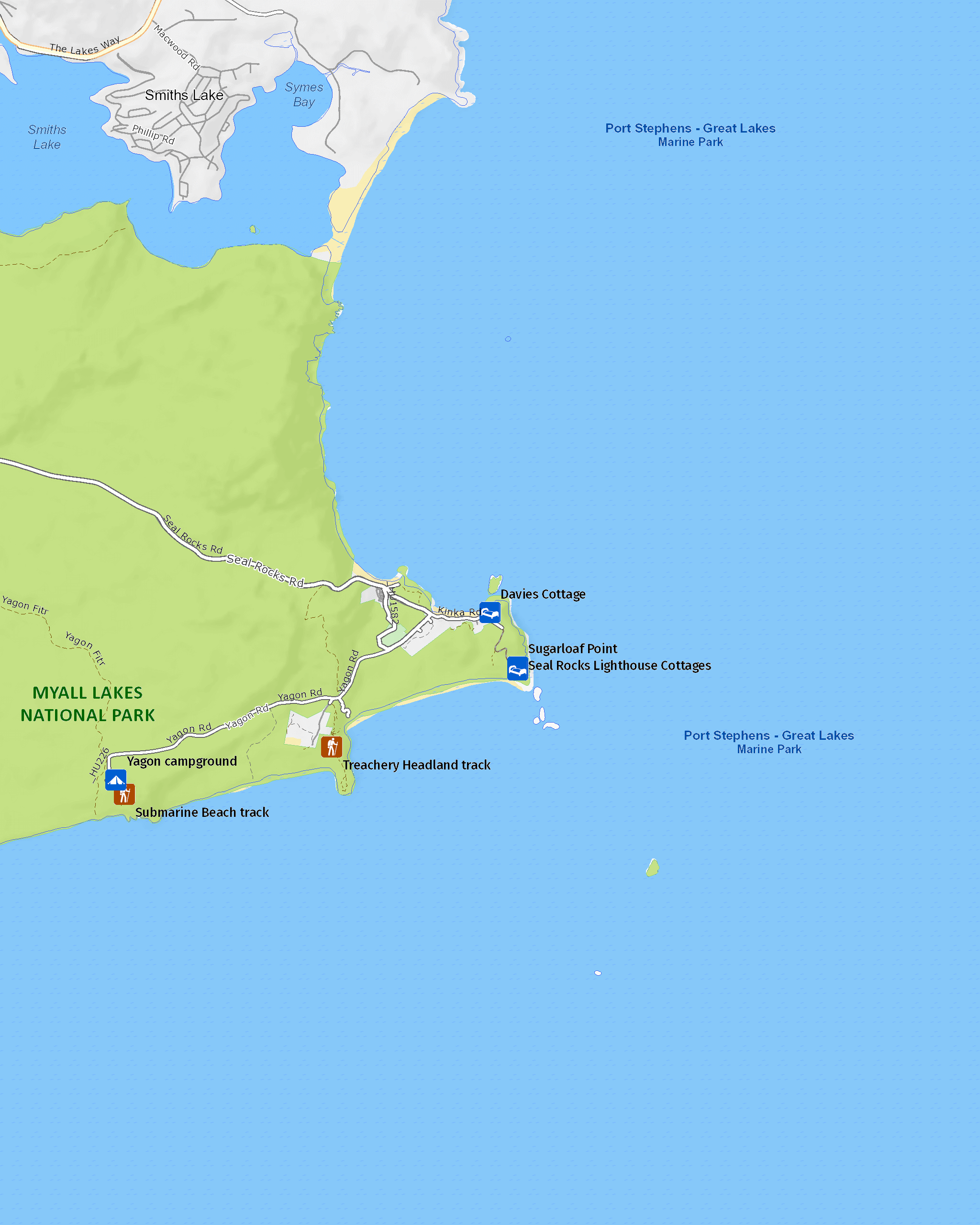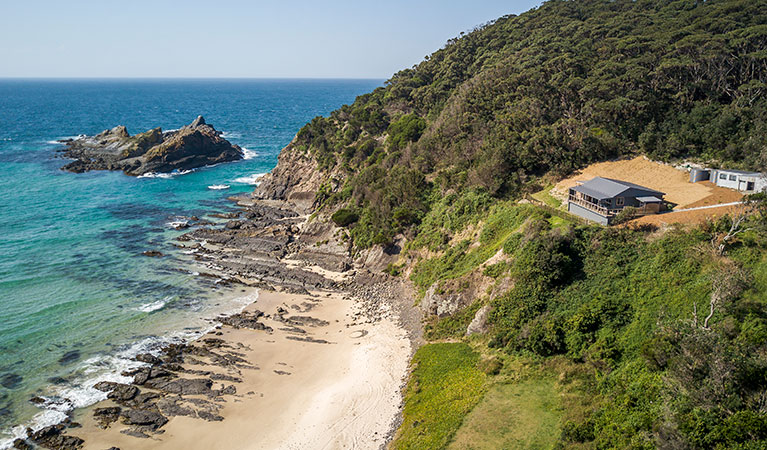Overview
For a coastal getaway only 40min from Forster, stay at Davies Cottage in Myall Lakes National Park. Nestled on a hillside near Sugarloaf Point Lighthouse, you’ll have unobstructed views of Boat Beach and Sugarloaf Bay.
| Accommodation type | Cottage |
|---|---|
| Where | 57 Kinka Road, Seal Rocks, NSW, 2423 - in Myall Lakes National Park |
| Bedrooms | 3 |
| Maximum guests | 6 |
| Facilities | Toilets, showers, drinking water, barbecue facilities, balcony, outdoor furniture, kitchen, plates and cutlery, pots and pans, bed linen, tv, towels, washing machine, electric power, carpark |
| What to bring | Bottled water, shampoo and soap, food supplies |
| Price | |
| Entry fees |
Park entry fees apply and can be paid at the time of booking. |
| Please note |
|
Davies Cottage is a convenient base to explore the beaches and walking tracks of the Mid North Coast. The large balcony overlooks the bay and the headlands, and you’ll have views of native bushland from the north side of the cottage.
In winter, you might spot whales from the comfort of the balcony. Or it’s only 800m to the historic Sugarloaf Point Lighthouse, a popular whale watching spot. Visit Lighthouse Beach while you’re here – if you’re lucky, you may see dolphins frolicking in the waves. After your swim, rinse off in the cottage’s outdoor bathroom and enjoy spectacular beach views from the privacy of the cottage.
You’ll find countless opportunities to swim, surf and fish during your stay. Explore Boat Beach right on your doorstep, or take Treachery Headland walk to secluded Treachery Beach. Venture a little further to Yagon campground and meander through lush coastal rainforest along Submarine Beach walking track. Enjoy scenic views from the viewing platform before arriving at a great surf spot.
As you enjoy a barbecue on the deck, keep an eye out for the kookaburras or pied butcherbirds that live in the area. During the warmer months, possums, tawny frogmouths and bandicoots can make an appearance in the evenings.
Nearby
-

Sugarloaf Point Lighthouse
The historic Sugarloaf Point Lighthouse, at the northern end of Myall Lakes National Park not far from Forster offers coastal views and is a top spot for whale watching.
-

Treachery Headland walking track
Pass through coastal rainforest to scenic views of Sugarloaf Point Lighthouse on this lovely walk. Take the sidetrack to Treachery Beach for a swim, surf or a spot of fishing.
Map

Map legend

Local alerts
For the latest updates on fires, closures and other alerts in this area, see https://www.nationalparks.nsw.gov.au/camping-and-accommodation/accommodation/davies-cottage/local-alerts
Bookings
- National Parks Contact Centre
- 7am to 7pm daily
- 1300 072 757 (13000 PARKS) for the cost of a local call within Australia excluding mobiles
- parks.info@environment.nsw.gov.au
Operated by
- Booti Booti Office
- Monday to Friday, 8.30am to 4.30pm. Closed public holidays.
- 02 6591 0300
- npws.manninggreatlakes@environment.nsw.gov.au
- The Ruins campground, Booti Booti National Park, 4374 The Lakes Way, Booti Booti 2428
Park info
- in Myall Lakes National Park in the North Coast region
Myall Lakes National Park is always open but may have to close at times due to poor weather or fire danger.
-
Park entry fees:
$8 per vehicle per day.
Day passes are available from a card operated pay machine at Mungo Brush campground or from the Manning Great Lakes Area Office. You can also pay for your visit via the Park’nPay app. You’ll need a Day Pass or Annual Pass when visiting the park.
Bombah Point ferry fees may also apply (cash payment only).
Buy annual pass.
Visitor info
All the practical information you need to know about Davies Cottage.
Getting there and parking
Davies Cottage is in Myall Lakes National Park, in the coastal town of Seal Rocks. To get there:
- Take The Lakes Way from the Pacific Highway
- Then take Seal Rocks Road towards Sugarloaf Point, past the shop and along Kinka Road.
- The cottage is on the left-hand side as you travel up the hill after Boat Beach, via a small laneway.
The cottage is at the top of a long driveway and cannot be seen from Kinka Road. There are 2 bird of paradise plants at the bottom of the driveway to help mark the location.
Road quality
- Sealed roads
Vehicle access
- 2WD vehicles (no long vehicle access)
Weather restrictions
- All weather
Parking
There is parking at the cottage for 2 cars under the carport.
Facilities
- There are 3 bedrooms. Bedrooms 1 and 2 have a queen bed and bedroom 3 has 2 king single beds. The master bedroom has direct access to the main deck.
- There are 2 bathrooms. The internal bathroom has a shower, toilet, hand basin and a washer/dryer. The separate external bathroom includes a shower, toilet and hand basin.
- Guest storage located behind the carport.
- Lounge, dining table with 6 chairs and ceiling fan in the lounge room.
- Vacuum and hairdryer.
Toilets
- Flush toilets
Showers
- Hot showers
Drinking water
The cottage has a rainwater harvesting system. The rainwater is not treated. You can either boil water before drinking or bring your own bottled water if you wish.
Barbecue facilities
- Gas/electric barbecues (free)
Balcony
Large deck and balcony.
Outdoor furniture
Outdoor setting with 6 dining chairs, 4 bar stools and 2 sun lounges.
Kitchen
Fridge, induction cooktop, microwave and dishwasher.
Plates and cutlery
Pots and pans
Bed linen
TV
TV and speaker.
Towels
Washing machine
Washer/dryer.
Electric power
Carpark
There are 2 parking spaces under the carport.
Maps and downloads
Accessibility
Disability access level - no wheelchair access
Prohibited
Please be considerate to your neighbours and avoid playing amplified music after 10pm.
Camp fires and solid fuel burners
Gathering firewood
Generators
Horses
Pets
Pets and domestic animals (other than certified assistance animals) are not permitted. Find out which regional parks allow dog walking and see the pets in parks policy for more information.
Smoking
NSW national parks are no smoking areas.
Learn more
Davies Cottage is in Myall Lakes National Park. Here are just some of the reasons why this park is special:
Ancient connections

Myall Lakes National Park is part of the Country of the Worimi Aboriginal people, who used the area's natural resources, like freshwater lakes, the ocean and native flora and fauna to live a traditional fisher-hunter-gatherer lifestyle. Much evidence of their long connection with this Country can be seen today throughout the middens in the park. The landscape of Myall Lakes includes important spiritual sites that are an important part of the identity of local Aboriginal people. Make sure you visit Dark Point Aboriginal Place while you're at visiting the park. This rocky headland has been of significance to Worimi people for at least 4000 years. The clans or nuras (family groups) within the Worimi people would gather together here for ceremonies and feasts.
- Dark Point Aboriginal Place Dark Point Aboriginal Place, in southern Myall Lakes National Park, is a culturally significant site for the Worimi people with scenic coastal views across to Broughton Island.
- Mungo walking track Mungo walking track offers a variety of Aboriginal and historic sites, diverse vegetation, and mountain biking in Myall Lakes National Park, near Hawks Nest.
Go fish

Fishing is a popular activity in Myall Lakes, with catches likely to include bream, whiting, Australian salmon, flathead and mullet. There are lots of great places in the park to throw in a line, like the beaches, lakes or rivers. Try fishing from your boat or for a relaxing day on the water you could try a spot of kayak fishing. At Myall Lakes you can also go camping, boating, swimming and canoeing. And when you’ve tried all of those, you can explore the park on foot, by 4WD or bike, stopping for a spot of bird watching or to enjoy a picnic or barbecue lunch along the way. Whatever your interests, there is bound to be something that takes your fancy.
- Mining Road to Old Gibber Road cycling trail Mining Road to Old Gibber Road cycling trail is an easy bike ride within Myall Lakes National Park. You can complete the ride in one day or take your tent to camp overnight.
- Mungo Rainforest walk Enjoy a short and easy rainforest walk with the birds in Myall Lakes National Park, not far from Buladelah. Afterwards, you can enjoy a picnic or barbecue at Mungo Brush.
Internationally recognised wetlands

Since 1999, this internationally recognised wetlands site, has been listed under the Ramsar Convention due to its diverse mosaic of near-natural wetlands, within a relatively unmodified coastal lake system. There are 18 different wetland types with extensive interconnected lake and river systems within the forested wetlands and swamps that fringe the waterways, rocky and sandy shores, and offshore islands off the coastline. This wetland site houses a complex variety of habitats with rich biodiversity, including threatened species and migratory birds protected under international agreements. The Myall Lakes wetlands also have a high cultural and social value as they occur within the traditional lands of the Worimi Aboriginal people, where the varied wetlands, environments and abundant resources provided an ideal living environment. Evidence of this traditional occupation exists across the landscape, including the Dark Point Aboriginal Place.
Plants and animals protected in this park
Animals
-

White-bellied sea eagle (Haliaeetus leucogaster)
White-bellied sea eagles can be easily identified by their white tail and dark grey wings. These raptors are often spotted cruising the coastal breezes throughout Australia, and make for some scenic bird watching. Powerful Australian birds of prey, they are known to mate for life, and return each year to the same nest to breed.
-

Long-nosed bandicoot (Perameles nasuta)
A nocturnal marsupial and one of the smaller Australian native animals, the long-nosed bandicoot is found across eastern Australia. Populations in the Sydney region have dwindled since European settlement, leaving only endangered colonies in inner western Sydney and at North Head, near Manly. The long-nosed bandicoot has grey-brown fur and a pointed snout which it uses to forage for worms and insects.
-

Brown-striped frog (Lymnastes peronii)
One of the most common frogs found in Australia, the ground-dwelling brown-striped frog lives in ponds, dams and swamps along the east coast. Also known as the striped marsh frog, this amphibian grows to 6.5cm across and has a distinctive ‘tok’ call that can be heard all year round.
-

Grey-headed flying-fox (Pteropus poliocephalus)
The grey-headed flying fox is Australia's largest native bat, with a wingspan up to 1m. This threatened species travels up and down south-eastern Australia and plays a vital role in pollinating plants and spreading seeds in our native forests.
-

Green and golden bell frog (Litoria aurea)
The green and golden bell frog is an endangered Australian frog. Once common on the NSW coast and tablelands, populations have plummeted around 90 percent.
Plants
-

Cabbage palm (Livistona australis)
With glossy green leaves spanning 3-4m in length and a trunk reaching a height of up to 30m, the cabbage tree palm, or fan palm, is one of the tallest Australian native plants. Thriving in rainforest margins along the east coast of NSW, in summer this giant palm produces striking spikes of cream flowers which resemble cabbages.
-

Wonga wonga vine (Pandorea pandorana)
The wonga wonga vine is a widespread vigorous climber usually found along eastern Australia. A variation of the plant occurs in the central desert, where it resembles a sprawling shrub. One of the more common Australian native plants, the wonga wonga vine produces bell-shaped white or yellow flowers in the spring, followed by a large oblong-shaped seed pod.

